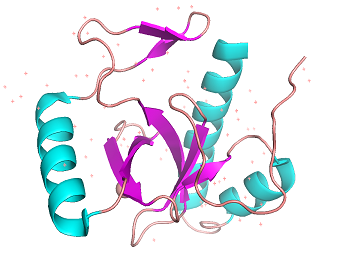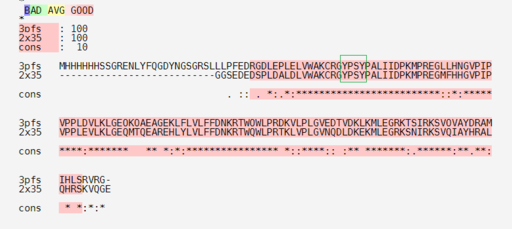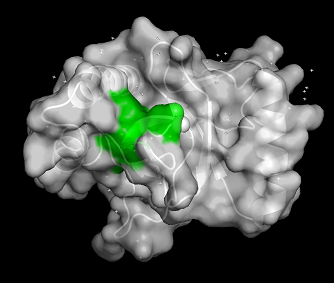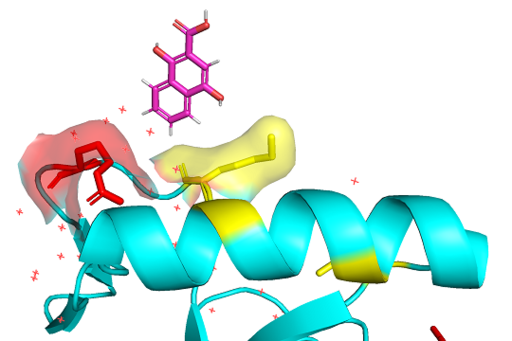Sandbox Reserved 897
From Proteopedia
(Difference between revisions)
| Line 8: | Line 8: | ||
== Structure == | == Structure == | ||
| - | The main characteristic of PWWP domains is the two distinctive substructural motifs: β-barrel at the N-terminal region and helixes at C-terminal region.<ref>Rona GB, Eleutherio EC, Pinheiro AS. PWWP domains and their modes of sensing DNA and histone methylated lysines. Biophysical reviews. 2016 Mar 1;8(1):63-74.</ref> 3PFS has a β-barrel composed of 5 β-strands, which is a very conservative feature of PWWP domains. The helixes at the C-terminal region are not very conservative; 3pfs has 3 helixes which are little more than many of its relatives. The Pro-Trp-Trp-Pro motif, which is the most conservative, is a little different from its name, just like its closely-related proteins. The PWWP domains in the BRPF family are composed of Tyr-Pro-Ser-Tyr and may suggest they would have a similar affinity. The stability of domain comes from both inter-substructure and intra-substructure interactions including hydrogen bonds and polar interactions. One unique feature of the PWWP motif is that the first position affects the stability and aggregation of the protein. The proline gives more stability and oligomerization to the protein, compared to the alanine at the same position.<ref>Hung YL, Lee HJ, Jiang I, Lin SC, Lo WC, Lin YJ, Sue SC. The first residue of the PWWP motif modulates HATH domain binding, Stability, and Protein–Protein Interaction. Biochemistry. 2015 Jul 7;54(26):4063-74.</ref> | + | The main characteristic of PWWP domains is the two distinctive substructural motifs: β-barrel at the N-terminal region and helixes at C-terminal region.<ref>Rona GB, Eleutherio EC, Pinheiro AS. PWWP domains and their modes of sensing DNA and histone methylated lysines. Biophysical reviews. 2016 Mar 1;8(1):63-74.</ref> 3PFS has a β-barrel composed of 5 β-strands, which is a very conservative feature of PWWP domains. The helixes at the C-terminal region are not very conservative; 3pfs has 3 helixes which are little more than many of its relatives. The Pro-Trp-Trp-Pro motif, which is the most conservative, is a little different from its name, just like its closely-related proteins. The PWWP domains in the BRPF family are composed of Tyr-Pro-Ser-Tyr and may suggest they would have a similar affinity. The stability of domain comes from both inter-substructure and intra-substructure interactions including hydrogen bonds and polar interactions. One unique feature of the PWWP motif is that the first position of arrangement affects the stability and aggregation of the protein. The proline gives more stability and oligomerization to the protein, compared to the alanine at the same position.<ref>Hung YL, Lee HJ, Jiang I, Lin SC, Lo WC, Lin YJ, Sue SC. The first residue of the PWWP motif modulates HATH domain binding, Stability, and Protein–Protein Interaction. Biochemistry. 2015 Jul 7;54(26):4063-74.</ref> |
[[Image:3pfs cartoon.png|thumb|center|512 px| '''Figure 1A:''' Cartoon model of 3PFS motif. β-sheets(magenta) and helixes(orange) are shown. generated in PyMOL using PDB: ''3PFS'']] | [[Image:3pfs cartoon.png|thumb|center|512 px| '''Figure 1A:''' Cartoon model of 3PFS motif. β-sheets(magenta) and helixes(orange) are shown. generated in PyMOL using PDB: ''3PFS'']] | ||
[[Image:3pfs alignment.png|thumb|center|512 px| '''Figure 1B:''' The alignment of BRPF1 PWWP domain and BRPF3 PWWP domain. The green box indicates the 'PWWP' motif. generated in Tcoffee using PDB: ''3PFS', '2X35'']] | [[Image:3pfs alignment.png|thumb|center|512 px| '''Figure 1B:''' The alignment of BRPF1 PWWP domain and BRPF3 PWWP domain. The green box indicates the 'PWWP' motif. generated in Tcoffee using PDB: ''3PFS', '2X35'']] | ||
Revision as of 20:23, 28 April 2020
| This Sandbox is Reserved from Jan 13 through July 31, 2020 for use in the course Protein Structure in Drug Discovery taught by Karen C. Glass at the ACPHS, Colchester, United States. This reservation includes Sandbox Reserved 895 through Sandbox Reserved 901. |
To get started:
More help: Help:Editing |
BRPF3 PWWP binding domain 3PFS
| |||||||||||
References
- ↑ Vermeulen M, Eberl HC, Matarese F, Marks H, Denissov S, Butter F, Lee KK, Olsen JV, Hyman AA, Stunnenberg HG, Mann M. Quantitative interaction proteomics and genome-wide profiling of epigenetic histone marks and their readers. Cell. 2010 Sep 17;142(6):967-80.
- ↑ Rona GB, Eleutherio EC, Pinheiro AS. PWWP domains and their modes of sensing DNA and histone methylated lysines. Biophysical reviews. 2016 Mar 1;8(1):63-74.
- ↑ Rona GB, Eleutherio EC, Pinheiro AS. PWWP domains and their modes of sensing DNA and histone methylated lysines. Biophysical reviews. 2016 Mar 1;8(1):63-74.
- ↑ Hung YL, Lee HJ, Jiang I, Lin SC, Lo WC, Lin YJ, Sue SC. The first residue of the PWWP motif modulates HATH domain binding, Stability, and Protein–Protein Interaction. Biochemistry. 2015 Jul 7;54(26):4063-74.
- ↑ Vezzoli A, Bonadies N, Allen MD, Freund SM, Santiveri CM, Kvinlaug BT, Huntly BJ, Göttgens B, Bycroft M. Molecular basis of histone H3K36me3 recognition by the PWWP domain of Brpf1. Nature structural & molecular biology. 2010 May;17(5):617-9.
- ↑ Vermeulen M, Eberl HC, Matarese F, Marks H, Denissov S, Butter F, Lee KK, Olsen JV, Hyman AA, Stunnenberg HG, Mann M. Quantitative interaction proteomics and genome-wide profiling of epigenetic histone marks and their readers. Cell. 2010 Sep 17;142(6):967-80.
- ↑ Rona GB, Eleutherio EC, Pinheiro AS. PWWP domains and their modes of sensing DNA and histone methylated lysines. Biophysical reviews. 2016 Mar 1;8(1):63-74.
- ↑ Qiu Y, Zhang W, Zhao C, Wang Y, Wang W, Zhang J, Zhang Z, Li G, Shi Y, Tu X, Wu J. Solution structure of the Pdp1 PWWP domain reveals its unique binding sites for methylated H4K20 and DNA. Biochemical Journal. 2012 Mar 15;442(3):527-38.
- ↑ Qiu C, Sawada K, Zhang X, Cheng X. The PWWP domain of mammalian DNA methyltransferase Dnmt3b defines a new family of DNA-binding folds. Nature structural biology. 2002 Mar;9(3):217-24.
- ↑ Rona GB, Eleutherio EC, Pinheiro AS. PWWP domains and their modes of sensing DNA and histone methylated lysines. Biophysical reviews. 2016 Mar 1;8(1):63-74.
- ↑ Alvarez-Venegas R, Avramova Z. Evolution of the PWWP-domain encoding genes in the plant and animal lineages. BMC evolutionary biology. 2012 Dec 1;12(1):101.
- ↑ Alvarez-Venegas R, Avramova Z. Evolution of the PWWP-domain encoding genes in the plant and animal lineages. BMC evolutionary biology. 2012 Dec 1;12(1):101.
- ↑ Vezzoli A, Bonadies N, Allen MD, Freund SM, Santiveri CM, Kvinlaug BT, Huntly BJ, Göttgens B, Bycroft M. Molecular basis of histone H3K36me3 recognition by the PWWP domain of Brpf1. Nature structural & molecular biology. 2010 May;17(5):617-9.
- ↑ Bjarkam CR, Corydon TJ, Olsen IM, Pallesen J, Nyegaard M, Fryland T, Mors O, Børglum AD. Further immunohistochemical characterization of BRD1 a new susceptibility gene for schizophrenia, and bipolar affective disorder. Brain Structure and Function. 2009 Dec 1;214(1):37.




